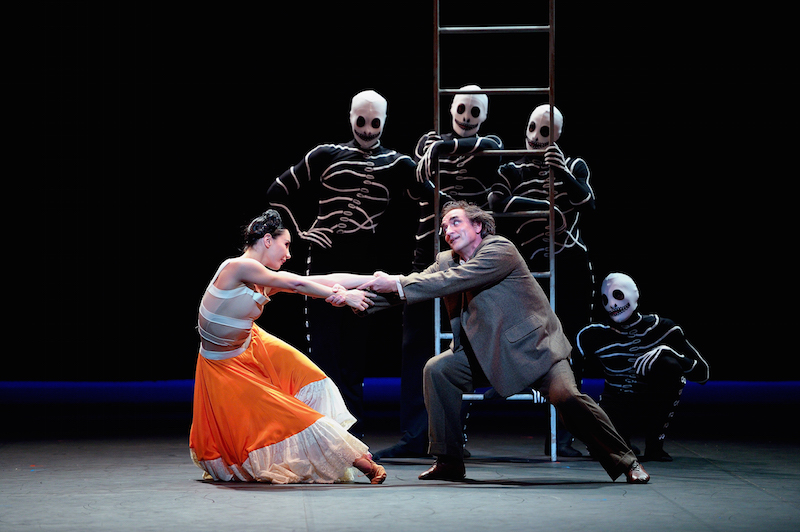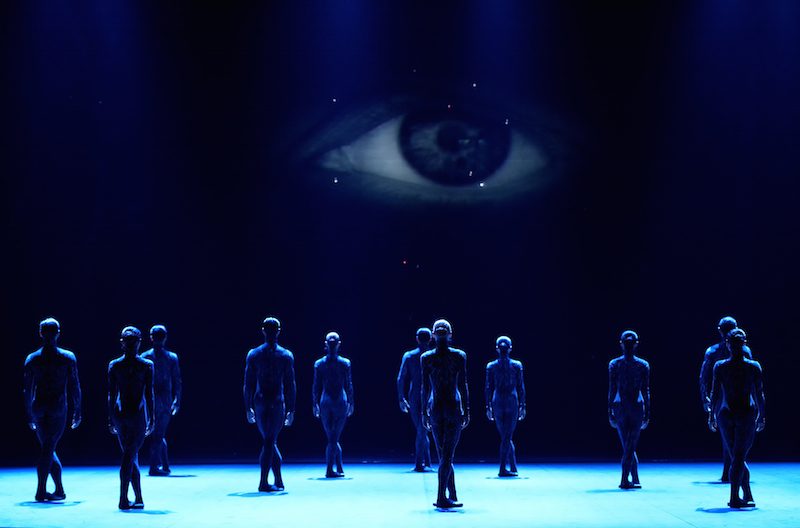Why are there so few female choreographers? Tamara Rojo, bugged by the fact that in 20 years on the ballet stage she had never danced anything choreographed by a woman, has stopped wondering and started doing something about it. ENB’s latest programme, an evening of three new commissions, sets out to show not only that women dance-makers can be just as accomplished as their better-known and vastly more numerous male counterparts, but also that their work can speak with a distinct voice. The clue is in the overarching title: She Said.
But before we get to the dancing, we are presented with an additional piece of art: a front cloth (pictured above) commissioned from that prominent part-time female Grayson Perry. It’s a glorious blast of colour and a great conversation-starter, filled as it is with dozens of tiny phallic symbols as well as images relating to the coming ballets. There, for example, is the artist Frida Kahlo imagined as a deer, complete with antlers, monobrow and pendulous breasts. And there is death, a grinning skeleton, mounted on her back. Around them is a landscape teeming with manmade objects – cars, planes, buildings, guns – all of which have assumed the shape of a cock and balls. The only pity is that Perry’s front cloth is seen so briefly at the start of the evening. The great Serge Diaghilev, a lover of front cloths who commissioned one from Picasso, no less, would surely have managed to get more prolonged bang for his buck. Broken Wings, a 40-minute treatment of the life of Frida Kahlo, makes a terrific opener which could just as easily have made a terrific closer. It has everything a ballet needs: content, surprise, strong roles for Its leading couple and strong ensembles, employed as eyefuls of luscious color and quirky interest, much in the manner of Kahlo’s paintings. You felt Annabelle Lopez Ochoa, the choreographer, had really got under her subject’s skin – almost literally at times, as she found striking ballet leitmotifs for aspects of the artist’s life, notably the bodily pain she suffered after a freak traffic accident in Mexico City in her teens left her with lifelong injuries.
Broken Wings, a 40-minute treatment of the life of Frida Kahlo, makes a terrific opener which could just as easily have made a terrific closer. It has everything a ballet needs: content, surprise, strong roles for Its leading couple and strong ensembles, employed as eyefuls of luscious color and quirky interest, much in the manner of Kahlo’s paintings. You felt Annabelle Lopez Ochoa, the choreographer, had really got under her subject’s skin – almost literally at times, as she found striking ballet leitmotifs for aspects of the artist’s life, notably the bodily pain she suffered after a freak traffic accident in Mexico City in her teens left her with lifelong injuries.
Tamara Rojo fills the role of Kahlo with all the dramatic verve and style we have come to expect of her, morphing from schoolgirl to bed-bound invalid to defiant, life-loving woman before our eyes. The onstage fast-changes of costume are a delight in themselves (design, Dieuweke van Reij). Veteran star Irek Mukhamedov is Diego Rivera, her raffish, on-off artist lover. Did he really need a fat suit to inhabit that part? It seems an indignity too far. Nevertheless, Mukhamedov dances with age-defying vigour, and his love duet with Rojo (pictured above) is a joy. What a relief to be shot of passion: here is choreographed love that is exuberant, playful, powered by wit and fun.
Blasts of Tijuana brass and louche maracas summon the heat of a Mexican fiesta
Even more impressive is the way Lopez Ochoa and dramaturg Nancy Meckler navigate a way through the story, dipping in and out of linear narrative and overlaying the whole with the vibrant symbolism of Kahlo’s paintings: the chorus of skeletons Kahlo is constantly batting away, choruses of animals, fruits and vegetation, the desperate, bloody images of her failed attempts to bear a child. Who would have believed a ballet could deal succinctly, and watchably, with the personal tragedy of miscarriage? This one does.
And its triumph is inseparable from Peter Salem’s score, a vast exotic landscape in itself. Blasts of Tijuana brass and louche maracas summon the heat of a Mexican fiesta, a husky Mexican balladeer croons along with the love affair, and Salem even finds a musical solution to the crash on the public bus. Here is a composer who understands exactly what a ballet needs to motor it along. Hats off, too, to conductor Gavin Sutherland and the ENB Philharmonic. This is exciting work, excitingly executed.
The other two works in the programme only patchily match the success of the first. M-Dao, by Chinese choreographer Yabin Wang, boils down the classical tragedy of Medea to a love triangle in which the distraught wronged partner murders her children it what appears to be a ghastly mistake. Imagining in her fevered state that she is destroying the betraying Jason and his new young wife, Erina Takahashi is superb as Medea, combining extreme physical flexibility with dramatic intensity.
The other star of the piece is the beautifully pared-down design by Kimie Nakano. The use of tumbling white silk to suggest the snuffing out of life is simultaneously shocking and beautiful. It comes as no surprise to learn that the choreographer also studied at film school: her manipulation of image, shadow and movement, all in monochrome, taking its cue from the cinema of Kurasawa. Less convincing, for me, was the score by Jocelyn Pook, which muddied the clear, oriental waters with Armenian-style singing – a fusion too far. Fantastic Beings, the final piece, by the Canadian Aszure Barton, is alone in being set to an existing orchestral work, and with good reason. Mason Bates’ Anthology of Fantastic Zoology, a symphonic juggernaut of a piece, is indeed hugely inspiring – a thrilling challenge to any large orchestra, too. The trouble is that the musical drama is so extreme that dance struggled to match it. And where were the fantastic beings of the title? Barton seemed torn between inventing fantasy animals and letting rip with ballet’s most spectacular classroom steps. Her best effects were the massed ones (pictured above), when the stage hummed with synchronised movement.
Fantastic Beings, the final piece, by the Canadian Aszure Barton, is alone in being set to an existing orchestral work, and with good reason. Mason Bates’ Anthology of Fantastic Zoology, a symphonic juggernaut of a piece, is indeed hugely inspiring – a thrilling challenge to any large orchestra, too. The trouble is that the musical drama is so extreme that dance struggled to match it. And where were the fantastic beings of the title? Barton seemed torn between inventing fantasy animals and letting rip with ballet’s most spectacular classroom steps. Her best effects were the massed ones (pictured above), when the stage hummed with synchronised movement.
Again, the design was a talking-point: unisex suits with the slithery look of sealskin, set against a night sky alive with glittering meteorites. If Tamara Rojo does secretly see herself as the next Diaghilev, she’s heading in the right direction. "Amaze me," he told his artists. And this triple bill, at least intermittently, is pretty amazing.















Add comment